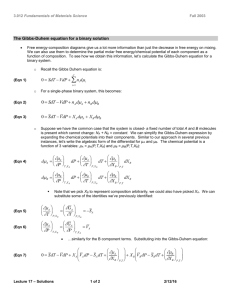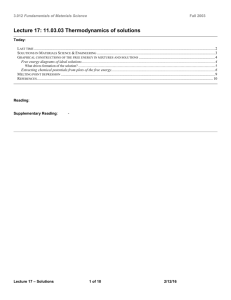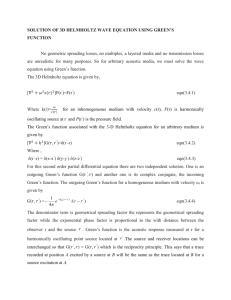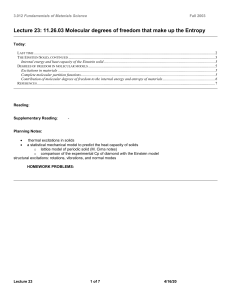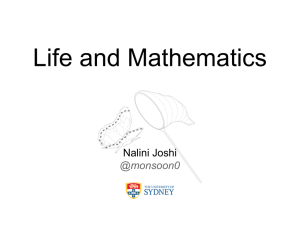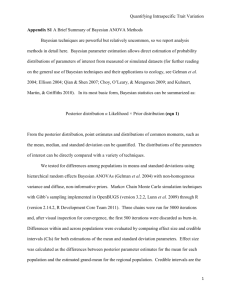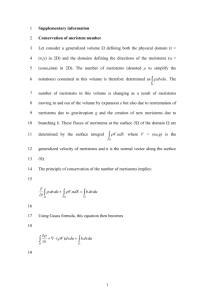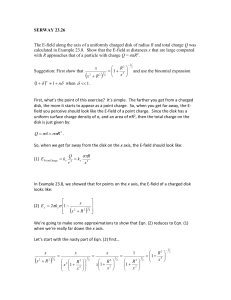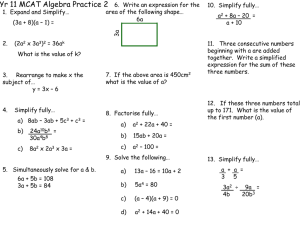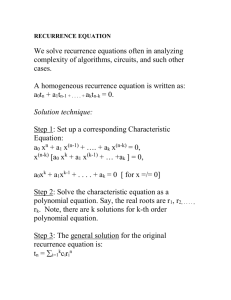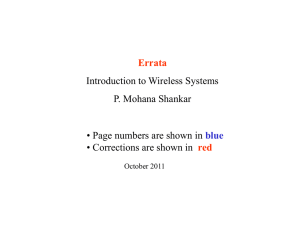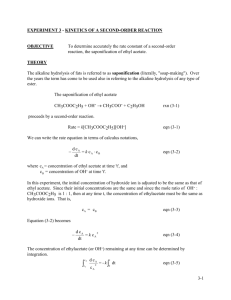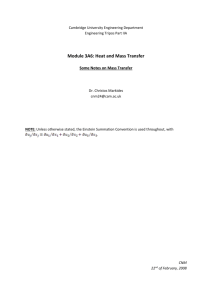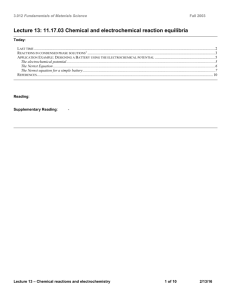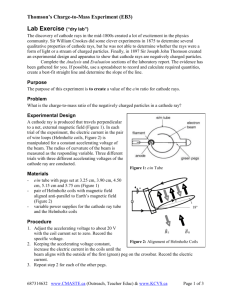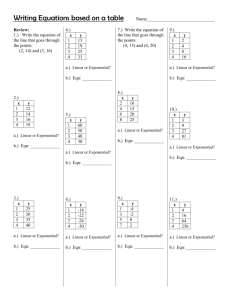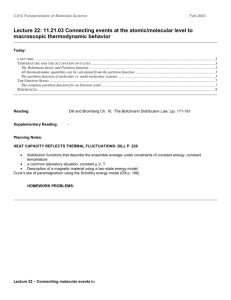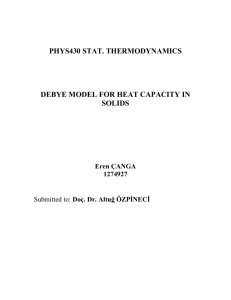Models of the chemical potential in materials
advertisement
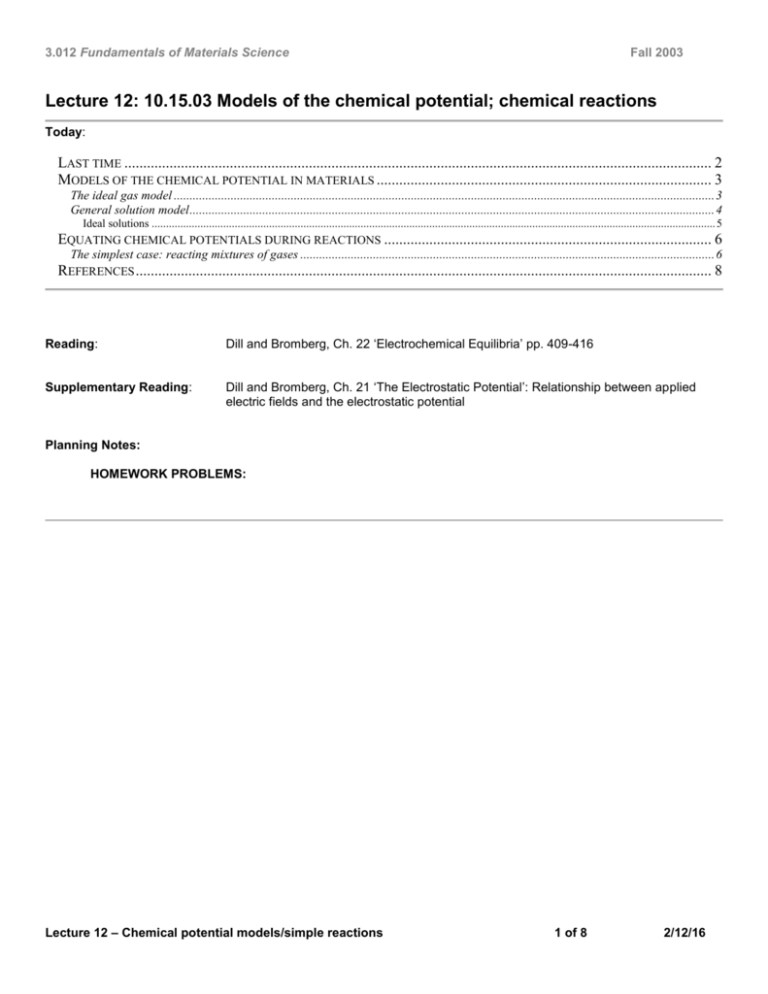
3.012 Fundamentals of Materials Science Fall 2003 Lecture 12: 10.15.03 Models of the chemical potential; chemical reactions Today: LAST TIME ............................................................................................................................................................ 2 MODELS OF THE CHEMICAL POTENTIAL IN MATERIALS ......................................................................................... 3 The ideal gas model ........................................................................................................................................................................... 3 General solution model ...................................................................................................................................................................... 4 Ideal solutions ..................................................................................................................................................................................................... 5 EQUATING CHEMICAL POTENTIALS DURING REACTIONS ....................................................................................... 6 The simplest case: reacting mixtures of gases ................................................................................................................................... 6 REFERENCES ......................................................................................................................................................... 8 Reading: Dill and Bromberg, Ch. 22 ‘Electrochemical Equilibria’ pp. 409-416 Supplementary Reading: Dill and Bromberg, Ch. 21 ‘The Electrostatic Potential’: Relationship between applied electric fields and the electrostatic potential Planning Notes: HOMEWORK PROBLEMS: Lecture 12 – Chemical potential models/simple reactions 1 of 8 2/12/16 3.012 Fundamentals of Materials Science Fall 2003 Last time Lecture 12 – Chemical potential models/simple reactions 2 of 8 2/12/16 3.012 Fundamentals of Materials Science Fall 2003 Models of the chemical potential in materials So far we’ve derived rules that the chemical potential must obey in the approach toward equilibrium, but we haven’t provided any equations that tell us what goes into the chemical potential. Because the chemical potential embodies chemical forces within materials, it is different for every material. However, several models for the chemical potential have been developed, which are the basis of many first-order calculations in materials science & engineering. These models will allow us to make predictions for the behavior of multi-component materials. The ideal gas model A starting point for models of the chemical potential is to consider perhaps the theoretically simplest form of matter- the ideal gas. Recall that the equation of state for the ideal gas is PV = nRT. From this equation of state, we can derive the chemical potential of the ideal gas. How do we begin? Consider a mixture of 2 different component ideal gases. The chemical potential of each component in the system is the partial molar free energy, so let’s start by determining the partial molar free energy of the ideal gas: dGi Si dT Vi dP (Eqn 1) o Remember that the partial molar free energy here is the change in free energy of the ideal gas system induced by addition of a mole of component i. We are considering a system that has a constant number of molecules. To continue, we need to know the molar entropy for the ideal gas. From the fundamental equation for the entropy, we know: dU i P dVi T T C nR V ,i dT dVi T Vi dSi (Eqn 2) o CV ,i R dT dVi T Vi In the second equality, we have made use of the definition of CV and the ideal gas equation of state. From this expression, we can integrate to obtain the entropy. It is convenient to determine the entropy to a defined reference state at a constant temperature: relative Sref current (T,V ) S So CV dT T T V Rln Vo (Eqn 3) o T V Vo current ref dS R dV V We use the un-subscripted parameters to refer to the current state, and the ‘o’ to denote the reference state. Since PV = nRT, PV PoVo , thus: Lecture 12 – Chemical potential models/simple reactions 3 of 8 2/12/16 3.012 Fundamentals of Materials Science Fall 2003 V Po Vo P (Eqn 4) Sref current (T,V ) Rln and Po P Where we have dropped the ‘current’ and are just using the un-subscripted parameters to represent the current state. Using the reference state entropy just calculated, we can determine the molar free energy to the reference state: relative o Gref current (T,V ) H ref current (T,V ) TSref current (T,V ) (Eqn 5) H ref current (T,V ) Rln P Po Now we need to know what the enthalpy of the ideal gas is: H U PV U nRT H i,ref current (Eqn 6) T T current ref dH i current ref dU i nR T dT T CV ,i dT nR T dT 0 T …the enthalpy change of the ideal gas is 0 for an isothermal process. Finally, we arrive at the molar free energy change: o Gi,ref current (T,V ) Gi Gi,o Hi,ref current (T,V ) Rln (Eqn 7) Pi P Rln i Po Po (Eqn 7) is an expression for the chemical potential in disguise, because: i Gi Gi,o Rln (Eqn 8) o Pi P i,o Rln i Po Po The chemical potential expression contains two parts: The partial molar free energy of the reference state, and the ‘excess’ chemical potential on moving from the reference state to the actual current state. General solution model The simple ideal gas model of the chemical potential above can be extended for use in describing general solid, liquid, or gaseous solutions. In the general solution model, the chemical potential is given by: (Eqn 9) i (X i,P,T) i,o (P,T) RT log ai Lecture 12 – Chemical potential models/simple reactions 4 of 8 2/12/16 3.012 Fundamentals of Materials Science o o Fall 2003 The chemical potential of component i is a function of its mole fraction, the pressure, and the temperature. To calibrate the value of the chemical potential in a given state, it is standard practice to refer to the chemical potential of that state relative to the pure component i in some reference state (typically atmospheric pressure). The first term is the chemical potential of the component in its reference state. One may see (Eqn 9) written as: i i,o RT log ai (Eqn 10) …which emphasizes that the term RT log ai quantifies the difference between the chemical potential of i in its current state from that of pure i in its reference state. to the reference state, we’ve also introduced a new quantity ai- the activity of component i. In addition The activity is further defined by introducing a second new quantity i, the activity coefficient: o ai i Xi (Eqn 11) o When we introduce statistical mechanics in the second half of the course, we will see how simple microscopic models of how the atoms and molecules in a material interact can give rise to the general solution model form of the chemical potential. Ideal solutions When the activity coefficient i = 1, the activity is equal to the mole fraction and the chemical potential reduces to: i i,o RT log X i (Eqn 12) Systems where this approximation holds are known as ideal solutions. The ideal solution can be shown to be the limiting behavior of any real very dilute solution. CARTER p. 214. Lecture 12 – Chemical potential models/simple reactions 5 of 8 2/12/16 3.012 Fundamentals of Materials Science Fall 2003 Equating chemical potentials during reactions We already know the chemical potential dictates mass flow- driving molecules from one phase into another in closed systems, or driving the addition/subtraction of molecules in open systems. But what about the case where two components can chemically react and be consumed to create a 3rd, completely new component? The chemical potential again controls the outcome. The simplest case: reacting mixtures of gases When components of a closed system can react, they must still obey the Gibbs condition to reach equilibrium: C dG i dX i 0 (Eqn 13) equilibrium condition at constant temperature and i1 pressure Let’s go through a simple example: the reaction of hydrogen and oxygen to form water vapor: 1 (Eqn 14) o 1 H2 O2 H2O 2 The moles of each component present are: o Plugging this information into the equilibrium condition (Eqn 13): o Recall the convention that Pi/Pi,0 is implied if we write Pi- we’ll use that below for simplicity. (Eqn 15) will only be true for non-zero dXH2O if: 1 1 H 2O,0 H 2 ,0 O2 ,0 RT log PH 2O log PH 2 log PO2 2 2 (Eqn 16) o The term on the left is the molar change in free energy for reaction of the components in their standard states if H2 and O2 react completely to become water: o Thus the term on the right re-arranges to: Lecture 12 – Chemical potential models/simple reactions 6 of 8 2/12/16 3.012 Fundamentals of Materials Science In general for a reacting ideal gas mixture, we have: o Fall 2003 Where is the stoichiometric coefficient for the reactant/product. Grxn is also referred to as the molar free energy of formation for the products C and D. DO AN EXAMPLE. Lecture 12 – Chemical potential models/simple reactions o 7 of 8 2/12/16 3.012 Fundamentals of Materials Science Fall 2003 References 1. Carter, W. C. 3.00 Thermodynamics of Materials Lecture Notes http://pruffle.mit.edu/3.00/ (2002). Lecture 12 – Chemical potential models/simple reactions 8 of 8 2/12/16
